- Home
- Bertolt Brecht
Bertolt Brecht: Mutter Courage und ihre Kinder 6
Bertolt Brecht: Mutter Courage und ihre Kinder 6 Read online
Bertolt Brecht
Collected Plays: Six
The Good Person of Szechwan
The Resistible Rise of Arturo Ui
Mr Puntila and his Man Matti
The sixth volume of Brecht’s Collected Plays contains three plays he wrote while on the run in the early stages of the Second World War. In The Good Person of Szechwan, the gods come to earth in search of a thoroughly good person. They find Shen Teh, a good-hearted prostitute, but she has to disguise herself as a man in order to muster sufficient ruthlessness to survive in an evil world.
The Resistible Rise of Arturo Ui is a witty and savage satire on the rise of Hitler – recast by Brecht in terms of a small-time Chicago gangster’s takeover of the city’s greengrocery trade. This translation by Ralph Manheim won the 1976 Schlegel-Tieck prize.
Mr Puntila and his Man Matti, one of Brecht’s finest comedies, is built around the dual personality of its central character. When drunk Puntila is human and humane; when sober, surly and self-centred. Oscillating unsteadily between these two poles, he plays havoc with his workmen, his women and the loyalty of his sardonic chauffeur, Matti.
Edited by John Willett and Ralph Manheim, the volume includes Brecht’s own notes and relevant texts as well as an extensive introduction and commentary.
Bertolt Brecht was born in Augsburg on 10 February 1898 and died in Berlin on 14 August 1956. He grew to maturity as a playwright in the frenetic years of the twenties and early thirties, with such plays as Man equals Man, The Threepenny Opera and The Mother. He left Germany when Hitler came to power in 1933, eventually reaching the United States in 1941, where he remained until 1947. It was during this period of exile that such masterpieces as Life of Galileo, Mother Courage and The Caucasian Chalk Circle were written. Shortly after his return to Europe in 1947 he founded the Berliner Ensemble, and from then until his death was mainly occupied in producing his own plays.
Other Bertolt Brecht publications by Bloomsbury Methuen Drama
Brecht Collected Plays: One
(Baal, Drums in the Night, In the Jungle of Cities, The Life of Edward II of
England, A Respectable Wedding, The Beggar or the Dead Dog,
Driving Out a Devil, Lux in Tenebris, The Catch)
Brecht Collected Plays: Two
(Man Equals Man, The Elephant Calf, The Threepenny Opera,
The Rise and Fall of the City of Mahagonny, The Seven Deadly Sins)
Brecht Collected Plays: Three
(Lindbergh’s Flight, The Baden-Baden Lesson on Consent, He Said
Yes/He Said No, The Decision, The Mother, The Exception and
the Rule, The Horations and the Curiatians, St Joan of the Stockyards)
Brecht Collected Plays: Four
(Round Heads and Pointed Heads, Fear and Misery of the Third Reich,
Señora Carrar’s Rifl es, Dansen, How Much Is Your Iron?,
The Trial of Lucullus)
Brecht Collected Plays: Five
(Life of Galileo, Mother Courage and Her Children)
Brecht Collected Plays: Six
(The Good Person of Szechwan, The Resistible Rise of Arturo Ui,
Mr Puntila and His Man Matti)
Brecht Collected Plays: Seven
(The Visions of Simone Machard, Schweyk in the Second World War,
The Caucasian Chalk Circle, The Duchess of Malfi )
Brecht Collected Plays: Eight
(The Days of the Commune, The Antigone of Sophocles,
Turandot or the Whitewashers’ Congress)
Berliner Ensemble Adaptations – publishing 2014
(The Tutor, Coriolanus, The Trial of Joan of Arc at Rouen 1431,
Don Juan, Trumpets and Drums)
Brecht on Art and Politics (edited by Tom Kuhn and Steve Giles)
Brecht on Film and Radio (edited by Marc Silberman)
Brecht on Performance: Messingkauf and Modelbooks – publishing 2014 (edited by
Tom Kuhn, Steve Giles and Marc Silberman)
Brecht on Theatre – publishing 2014 (edited by Marc Silberman, Steve Giles and Tom Kuhn)
Brecht in Practice – publishing 2014 (David Barnett)
The Craft of Theatre: Seminars and Discussions in Brechtian Theatre (Ekkehard Schall)
Brecht, Music and Culture – publishing 2014 (Hans Bunge, translated by Sabine Berendse and Paul Clements)
Brecht in Context (John Willett)
The Theatre of Bertolt Brecht (John Willett)
Brecht: A Choice of Evils (Martin Esslin)
Bertolt Brecht: A Literary Life – publishing 2014 (Stephen Parker)
A Guide to the Plays of Bertolt Brecht (Stephen Unwin)
Bertolt Brecht
Collected Plays: Six
The Good Person of Szechwan
translated by John Willett
Original work entitled:
Der gute Mensch von Sezuan
The Resistible Rise of Arturo Ui
translated by Ralph Manheim
Original work entitled:
Der aufhaltsame Aufstieg des Arturo Ui
Mr Puntila and his Man Matti
translated by John Willett
Original work entitled:
Herr Puntila und sein Knecht Matti
Edited and introduced by
John Willett and Ralph Manheim
Contents
Introduction
Chronology
THE PLAYS
THE GOOD PERSON OF SZECHWAN
THE RESISTIBLE RISE OF ARTURO UI
Chronological Table
MR PUNTILA AND HIS MAN MATTI
The Puntila Song
NOTES AND VARIANTS
THE GOOD PERSON OF SZECHWAN
Texts by Brecht
The Song from the Opium Den
Fragment of a Story
Press Report
Working Plan
Undated notes
Li Gung’s big speech about the punishment imposed by the gods for failing to eat meat
From Brecht’s Journal
The Good Person of Szechwan
Alternative Epilogue
Editorial Note
1. Development of the first idea
2. The Finland version
3. Account of the first script
4. The Zurich script of 1943
5. The Santa Monica version
THE RESISTIBLE RISE OF ARTURO UI
Texts by Brecht
Instructions for performance
Alternative Prologues
Notes
Later Texts
Notes by Manfred Wekwerth
Songs for the Berliner Ensemble production
Editorial Note
MR PUNTILA AND HIS MAN MATTI
A Finnish Bacchus by Hella Wuolijoki
Texts by Brecht
A note of 1940
Notes on the Zurich première
Notes on the Berliner Ensemble production
Notes on the Puntila film
Editorial Note
Preliminary ideas
Scene-by-scene account
Introduction
Following Galileo (first version, Denmark, 1938) and Mother Courage (Sweden, 1939), in which Brecht had first turned away from day-to-day politics and any immediate possibilities of production, the present volume contains the three works written in Finland after the end of the ‘phoney war’ while the family was waiting to move on a stage further, to the United States. One play, The Good Person of Szechwan, had been in his mind for a long time, and demanded constant reworking. One was the product of his Finnish experiences (which also inspired a new vein of poetry) and grew from a draft comed
y by his hostess there. The third was written in haste, meant to be staged in America once their precarious journey had been achieved. All three demanded large casts. And none could be performed as Brecht himself wanted until after his return to Europe in 1947.
Like The Caucasian Chalk Circle later, The Good Person of Szechwan stands out from his more didactic and politically committed works by being conceived as a ‘parable’ – a description not previously used for his plays – with ethical problems as its main concern. More than once in his journal he complains about its complicated history: conceived some ten years before he began serious work on it, then worked on successively in Denmark, Sweden and Finland till he reluctantly undertook a last revision at the beginning of 1941, he was never able to give it the final test by staging it under his own direction. At bottom the problem was how to maintain the original social point when the Chinese setting risked becoming (as he noted in mid-1940) a ‘mere disguise, and a ragged disguise at that’. For the short play which he had sketched in 1930 as Die Ware Liebe (a pun roughly equivalent to ‘Love is the Goods’) was on a theme close to that of his story ‘The Job’ (Short Stories 1921–1946, p. 112): a society where women’s role was to be sold, but salesmen had to be men. This, rather than the ambiguities of good and evil, is what suggested that the Person should be a whore.
Just when Brecht first thought of locating the play in China we do not know, but it must have been at some point between Piscator’s production of Friedrich Wolf’s Tai Yang Wakes Up (a counter-play to Klabund’s 1924 Chalk Circle) and the first reference to it in his journal for March 1939, by which time it was already an unfinished fragment consisting of five scenes under its present title. ‘A thin structure of steel’, he called it, and clearly he did not wish it to have an exotic flavour:
the girl must be a big powerful person. the city must be a big, dusty uninhabitable place. […] some attention must be paid to countering the risk of chinoiserie. the vision is of a chinese city’s outskirts with cement works and so on. there are still gods around but aeroplanes have come in. perhaps the lover should be an unemployed pilot?
Repeatedly he seems to have become uneasy about the local colour and the degree of realism needed: was Shen Teh, for instance, to give her impoverished neighbours bread, or milk, or rice? Originally a vague name for the city, Szechwan itself, which is more properly the name of a province, became specified in the stage directions as ‘The capital of Szechwan, which has been semi-europeanised’. This would-be precision, which contrasts oddly with his later insistence that Szechwan stands indifferently for ‘all those places where man is exploited by man’, is less vivid in the end than some of Brecht’s wilder flights of geographical fantasy, for instance in Man equals Man. Even then his use of Chinese theatrical techniques had to be accentuated during the last laborious revisions before the play was duplicated. This was done so as to ‘add a poetic element’, making it lighter and more entertaining in an effort to compensate for its undue length.
• • •
Duplicated scripts went off early in 1941 to Piscator and Kurt Weill in the United States, as well as to recipients in Sweden and Switzerland, the latter including the Zurich Schauspielhaus, who were even then preparing the world première of Mother Courage. Piscator seems to have been the first to react, and within a few weeks of Brecht’s arrival in California on 21 July 1941 he responded enthusiastically, saying that he had begun negotiating about a possible production with the Theatre Guild; moreover the poet John Latouche, author of the patriotic-progressive ‘Ballad for Americans’, was interested in translating the play. Brecht however was not prepared to be hurried, preferring to wait until he knew whether he himself would be coming to New York, and meanwhile suggesting to Piscator that Arturo Ui would be a simpler play to mount. Whether he had already heard about the productions of Piscator’s Dramatic Workshop at the New School is not clear, but they had featured a version of the Klabund Chalk Circle that March starring Dolly Haas (of Broken Blossoms fame) as the heroine, a performance which the New York Post praised for its ‘quaintness and delicacy’; and soon the poet Hoffman Hays was warning Brecht that Piscator’s errors of judgement might harm him with the Guild. It may have been as a result of this that he now began looking elsewhere for the possibility of a production, showing the script to Elisabeth Bergner, who knew his work from Munich and Berlin and was predisposed to help. Not only had she had one of her great successes in Klabund’s play in 1924, but she was now told by Brecht that he had written The Good Person specifically for her to act (though all the early scripts carry a dedication to Helene Weigel), and what she heard of its story clearly intrigued her. On reading it however she found it boring and guessed that others would as well, while the film actress Anna May Wong – yet another who had acted in the Klabund play, this time in London in 1931 – seems to have lost interest after a first meeting in Hollywood engineered by Alexander Granach, another of Brecht’s Berlin friends.
The sole effect of these approaches to actresses, then, was to enrage Piscator, who saw that he was being neglected and by-passed and felt that this was a poor reward for all his efforts to get Brecht invited to the United States in the first place. It looks as if Brecht then shunted the play into the sidings while he concentrated on the writing of Fritz Lang’s Czech resistance film Hangmen Also Die. One night in August 1942 however his old friend the novelist Lion Feuchtwanger telephoned to say that he had heard from Zurich that the Schauspielhaus there wanted to produce the script which Brecht had sent them before leaving Europe. This decision came at a crucial turning point in the military fortunes of the Allies, shortly before the victories of Alamein and Stalingrad, and from then on Zurich became for some years Brecht’s European base. Naturally he was not yet able to see any productions there, let alone to exert any kind of influence on the interpretation of his plays, and it is difficult even now to judge how far the committedly anti-Nazi Schauspielhaus company managed to grasp all his ideas. But at least its initial reception, unlike that of Mother Courage and (later) Puntila, never led Brecht to make any corrective changes to the text, which accordingly became the authorised version as we now have it.
And yet within a matter of weeks Brecht was planning a major rewrite which was to lead – as later in the case of Galileo – to the making of a shorter, tighter and in some ways stronger ‘version for here’, i.e. for the American stage. This originated in Kurt Weill’s reaction to the script that Brecht had sent him, which the now successful composer wanted to make into a (presumably musical) play for Broadway production. During a long visit to New York (February to May inclusive) Brecht therefore spent a week with the Weills, establishing the outline given on pp. 325–30 of our notes. This, it seems, was to form the basis for a production to be set up some while after that of the Schweik musical which they were planning at the same time and hoped to have ready by the autumn. The full script must then have been written during the summer of 1943, after the completion of Schweyk in the Second World War: typed by Brecht, it is headed ‘1943 version’ and datelined ‘Santa Monica 1943’. It eliminates two scenes and five characters and is roughly two-thirds of the length of the Zurich (authorised) version; and it can be reconstructed from the passages quoted on pp. 336–51. Probably this is the version which Brecht gave Christopher Isherwood to read that September in the hope that he might translate it; however, only ‘a few polite compliments’ resulted. Weill anyway wanted a more radical adaptation by an American writer, possibly the black poet Langston Hughes, who later wrote the adaptation of Street Scene for him. By November it seems that the new Brecht version had been shelved, and that winter a contract was made giving Weill the right to choose his own librettist and lyric writer, along with exclusive production rights for the next two and a half years. By then he had come round to the idea of a ‘semi-opera’ – the term which he had used of Silver Lake in 1933, with its separate musical ‘numbers’. (He never entirely abandoned the idea, but the work had still not been started when he died in 1950.)
>
For at least a year Weill’s interest put a stopper on any further production plans, and although Brecht speculated about the possibility of setting the play in Jamaica with an all black cast (and a translation by Auden) it never rose to the surface of his concerns again until he left America for Switzerland in November 1947. It was only after that point that a wave of American college and university productions began, using the Two Parables translation which Eric and Maya Bentley had made at Brecht’s request on the basis of the 1940 text. Perhaps it was this that once again aroused Broadway’s interest, but by now Brecht was quite as reluctant to commit himself as he had been in the case of Piscator and the Theatre Guild. In particular he did not want any experimental productions in New York; Shen Teh must be played by ‘an artiste of the first rank’ (Jessica Tandy for example); while Bentley himself should not venture to direct in ‘the hopeless atmosphere of Broadway’ without first gaining experience with Brecht’s own company in Berlin. As a result it was only after the writer’s death in August 1956 that the play finally reached New York, when T.E. Hambleton put on a production that December at the Phoenix Theatre, directed by Bentley with Uta Hagen as Shen Teh. Two months earlier George Devine had staged it at the Royal Court Theatre in London with Peggy Ashcroft, after visiting Brecht earlier in the year and gaining his approval. Both these first productions had music by Paul Dessau and sets by Teo Otto, friends and accepted interpreters of Brecht.
How highly did Brecht himself rank the play? Certainly he never gave it a particularly high priority where German productions were concerned, and it seems that Brecht still regarded The Good Person as an unusually difficult play to deal with, for all the apparent ease of its acceptance at college level. Nor were matters helped by the fact that its first professional postwar production was licensed and prepared without his being consulted; indeed the Brecht literature generally ignores it. This took place at Max Reinhardt’s former Vienna theatre, the eighteenth-century Theater in der Josefstadt, where there was a production by Rudolf Steinbóck in March 1946 with the outstanding actress Paula Wessely as Shen Teh; conservative Austrian critics felt she was too cold. It was another six years before Harry Buckwitz in Frankfurt mounted the first West German production, a somewhat dragging affair with Solveig Thomas as a clearly much sweeter and daintier Shen Teh. A number of other West German performances followed before Brecht, who had spent four days with Buckwitz in Frankfurt trying ‘to infuse ease and clarity into the production’, gave his young Swiss assistant Benno Besson the task of directing the play’s East German première at Rostock. With Käthe Reichel as a dialectically polarised Shen Teh this laboured the play’s antitheses and stressed the links between the Chinese city and Western capitalism. It was conceived as a pilot production for Besson and Reichel to develop eighteen months later at the Berliner Ensemble.

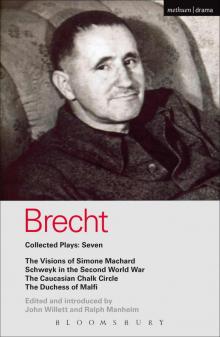 Bertolt Brecht: Mutter Courage und ihre Kinder 7
Bertolt Brecht: Mutter Courage und ihre Kinder 7 Bertolt Brecht
Bertolt Brecht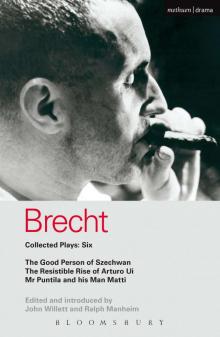 Bertolt Brecht: Mutter Courage und ihre Kinder 6
Bertolt Brecht: Mutter Courage und ihre Kinder 6 Bertolt Brecht: Mutter Courage und ihre Kinder 4
Bertolt Brecht: Mutter Courage und ihre Kinder 4 Bertolt Brecht: Mutter Courage und ihre Kinder 2
Bertolt Brecht: Mutter Courage und ihre Kinder 2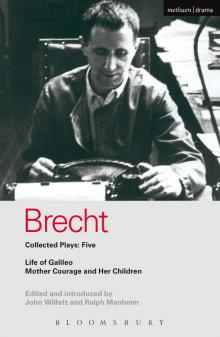 Bertolt Brecht: Mutter Courage und ihre Kinder 5
Bertolt Brecht: Mutter Courage und ihre Kinder 5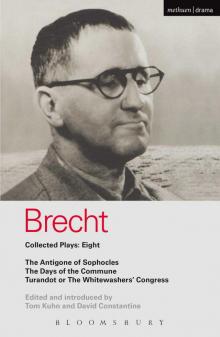 Collected Plays, Volume 4 (Bertolt Brecht: Plays, Poetry & Prose) 8
Collected Plays, Volume 4 (Bertolt Brecht: Plays, Poetry & Prose) 8 Mother Courage and Her Children
Mother Courage and Her Children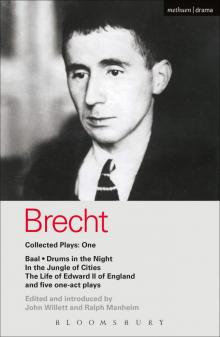 Bertolt Brecht: Mutter Courage und ihre Kinder 1
Bertolt Brecht: Mutter Courage und ihre Kinder 1 Brecht Collected Plays: 3: Lindbergh's Flight; The Baden-Baden Lesson on Consent; He Said Yes/He Said No; The Decision; The Mother; The Exception & the ... St Joan of the Stockyards (World Classics)
Brecht Collected Plays: 3: Lindbergh's Flight; The Baden-Baden Lesson on Consent; He Said Yes/He Said No; The Decision; The Mother; The Exception & the ... St Joan of the Stockyards (World Classics)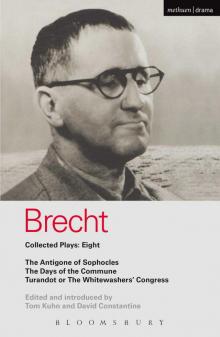 Brecht Plays 8: The Antigone of Sophocles; The Days of the Commune; Turandot or the Whitewasher's Congress: The Antigone of Sophocles , The Days of the Comm (World Classics)
Brecht Plays 8: The Antigone of Sophocles; The Days of the Commune; Turandot or the Whitewasher's Congress: The Antigone of Sophocles , The Days of the Comm (World Classics)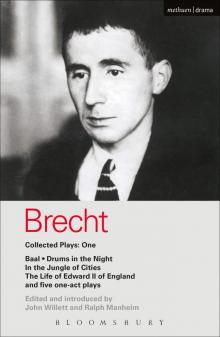 Brecht Collected Plays: 1: Baal; Drums in the Night; In the Jungle of Cities; Life of Edward II of England; & 5 One Act Plays: Baal , Drums in the Night , In the Jungle of Ci (World Classics)
Brecht Collected Plays: 1: Baal; Drums in the Night; In the Jungle of Cities; Life of Edward II of England; & 5 One Act Plays: Baal , Drums in the Night , In the Jungle of Ci (World Classics)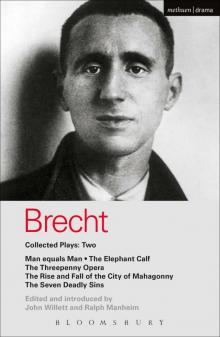 Brecht Collected Plays: 2: Man Equals Man; Elephant Calf; Threepenny Opera; Mahagonny; Seven Deadly Sins: Man Equals Man , Elephant Calf , Threepenny Ope (World Classics)
Brecht Collected Plays: 2: Man Equals Man; Elephant Calf; Threepenny Opera; Mahagonny; Seven Deadly Sins: Man Equals Man , Elephant Calf , Threepenny Ope (World Classics)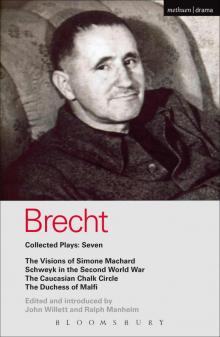 Brecht Collected Plays: 7: Visions of Simone Machard; Schweyk in the Second World War; Caucasian Chalk Circle; Duchess of Malfi (World Classics)
Brecht Collected Plays: 7: Visions of Simone Machard; Schweyk in the Second World War; Caucasian Chalk Circle; Duchess of Malfi (World Classics)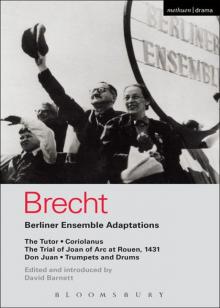 Berliner Ensemble Adaptations
Berliner Ensemble Adaptations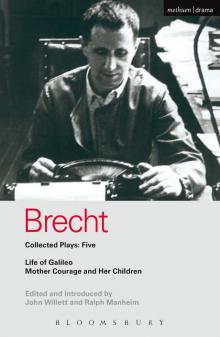 Brecht Collected Plays: 5: Life of Galileo; Mother Courage and Her Children (World Classics)
Brecht Collected Plays: 5: Life of Galileo; Mother Courage and Her Children (World Classics)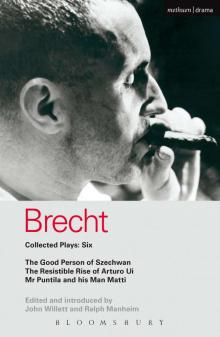 Brecht Collected Plays: 6: Good Person of Szechwan; The Resistible Rise of Arturo Ui; Mr Puntila and his Man Matti (World Classics)
Brecht Collected Plays: 6: Good Person of Szechwan; The Resistible Rise of Arturo Ui; Mr Puntila and his Man Matti (World Classics)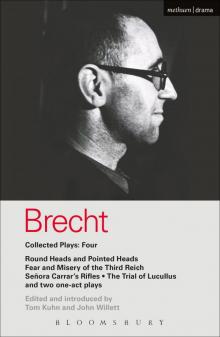 Brecht Collected Plays: 4: Round Heads & Pointed Heads; Fear & Misery of the Third Reich; Senora Carrar's Rifles; Trial of Lucullus; Dansen; How Much Is ... and Misery , Carr (World Classics)
Brecht Collected Plays: 4: Round Heads & Pointed Heads; Fear & Misery of the Third Reich; Senora Carrar's Rifles; Trial of Lucullus; Dansen; How Much Is ... and Misery , Carr (World Classics)